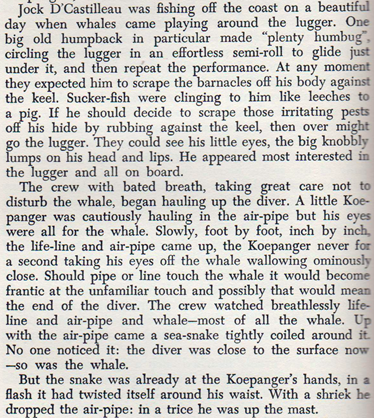I’ve read right through that pile of Aboriginal books now, and have borrowed Rabbit Proof Fence (book) and three DVDs, about Mabo and two other aboriginal topics.
In my extra spare time I’ve been reading more Idriess. The book “Lassiter’s Last Ride” has photos of laughing aborigines. The book “The great boomerang” has good examples of Aboriginal humour.
Major books published by Ion L. Idriess. Marking the ones that I’ve read.
I have an order in for “The Yellow Joss”. I’d like to read “Drums of Mer”, “Lightning Ridge”, “The Tin Scratchers” and “Our Living Stone Age”.
Idriess’ biographer says that “The desert column” is by far his best book. I haven’t read it and don’t want to. Ditto “Horrie the wog dog”. I don’t like war stories.
Best Idriess I’ve read by far is “Gold dust and ashes” – terrible title, great book. It’s about the gold rush in Wau, New Guinea. So much history happened in just a few years. In real life, Idriess made it to New Guinea at exactly the wrong time to join the rush, so went exploring up the Fly River instead.
“Fortunes in Minerals” is the sequel to “Prospecting for Gold”. They’re both good non-fiction handbooks for prospectors, and both start with the stuff everyone knows before moving on to much more advanced techniques. “Sniping” is another non-fiction handbook, Idriess was never a sniper but he was a spotter for a sniper, so if you want to be a live sniper this is the book to read.
First hand accounts of aborigines are in “Over the Range”, a great book, and “In Crocodile Land” which is funnier but less useful. These should be considered primary sources.
“Man Tracks” is basically a sequel to “Over the Range”. “Nemarluk” is basically a sequel to “Man Tracks”.
Of the others “The cattle king” is my favourite. About Kidman. If you want to know what a drought really is, read this book. Ditto if you want to learn how to become very rich.
“Lasseter’s Last Ride” – I thought it was going to be Idriess’s worst book, but then came three chapters about “the stick” which provides a deeper insight into Aboriginal religion (and possibly even Aboriginal pre-European history) than anything I’ve come across anywhere.
“Flynn of the Inland” – ho hum.
“Forty Fathoms Deep” – pearling in Broome. Starts with what looks like a murder mystery – how many people who handled a giant stolen pearl had early violent deaths? At least six. The final chapters are good – natural history combined with comedy. It also helps explain what happens when you put 6 separate racial groups in one town.
“The Great Trek” – Prequel to “Coral Sea Calling”, about Kennedy and the Jardines in Cape York. Ho hum.
“The Great Boomerang” – ostensibly a book about Idriess’ plan to divert water from coastal Queensland into the interior of Australia. Actually a great yawn, but does have a great little section about native tobacco preparation. And has what was then known about megafauna.
“Isles of Despair” – about Barbara Thompson, the woman captured by Cape York aborigines. Not a good book because so few authentic extant records of what she went through.
“Stone of Destiny” – about Australian diamonds (pre-Argyle days). Very difficult to write because there aren’t any, apart from a few small ones accidentally discovered during tin mining. Good story about Antwerp’s training of diamond cutters.
“The Red Chief” – based on an extensive interview with the last Aboriginal chief of the Gunnedah area, together with information from several corroborees. Mostly authentic, but not the parts about the kidnapping of two teenage girls or the education of boys.
“The Silver City” – Broken Hill. Gave up because it was so boring, but is said to be Autobiographical of Idriess’ teens.
“Coral Sea Calling” – moving history up the Qld coast from Brisbane through to “Warrior Island” via “the new Singapore”.
———————
Overview. Idriess, apart from in his handbooks, reads like a set of tall stories. Partly because he mentions few dates and few references. But they are as factual as possible with detailed scholarship. (Every time I’ve thought that Idriess is inventing events, he’s always brought me back to Earth by explaining how he obtained the information). Full of comedy and tragedy – mostly comedy.
Idriess is the author with a better understanding of the non-city aborigines than any other, living with the aborigines and melanesians far from cities for longer than any other author of that era (1909 to 1931). He was interviewed by the Commission that dissolved the Aboriginal Protective Association in NSW as an expert in top end aborigines. Even more than in his books, perhaps, his writings about the aborigines in many issues of “The Bulletin” define him as an expert.
An example of classic Idriess humour.

—————-
The Idriess plan, I’m starting an engineering evaluation of this. eg. I’ve calculated that this amounts to an increase of close to 10% to the combined catchment basins of Lake Eyre and the Bulloo River. Is this really enough to make any difference?
This is the Idriess Plan. I’ve numbered the four new catchment areas.